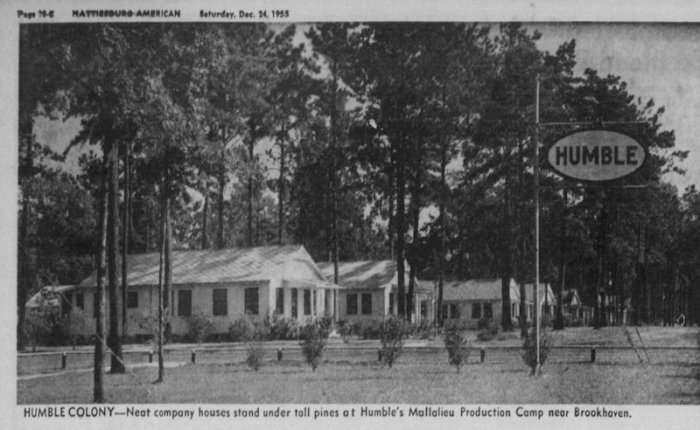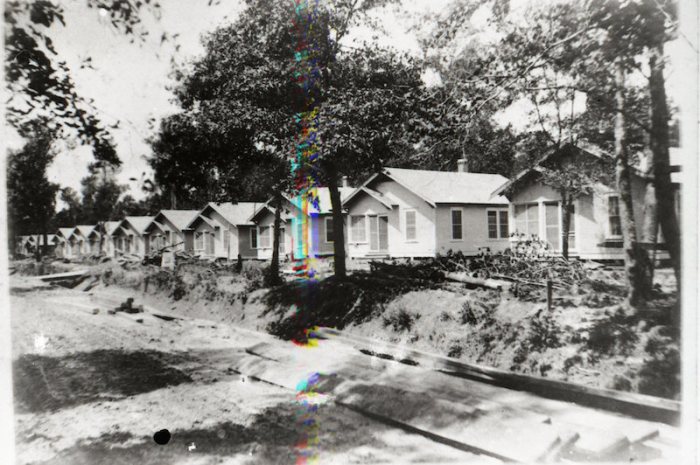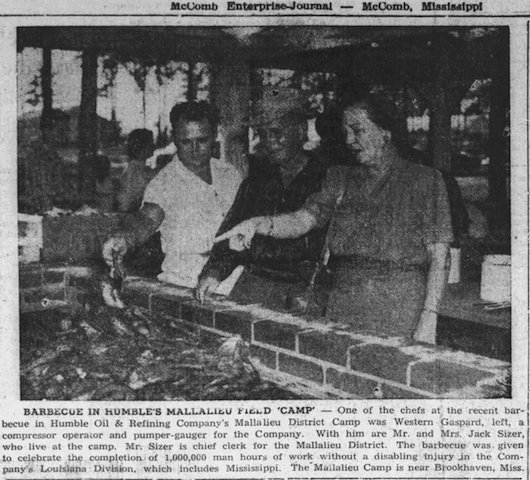
Because MissPres readers have found the Friday is a Gas series fascinating, you will understand why I was hooked when I stumbled upon this news item about the Humble Camp near Brookhaven. Mississippi, or at least one Mississippian, had a role in the Humble Oil and Refining Company of Texas. Because information about the Mallalieu Production Camp was quite limited, I have relied on sources from other Humble Camps and oilfield camps in order to fill in some of the blanks about “company housing.” As always, I hope if anyone reading has more information, clarification, or memories of this part of Lincoln County history, you will share that with us in the comments.
The Mississippi connection to Humble Oil began in 1901 when William Stamps Farish graduated from the University of Mississippi law school, where he was President of the Blackstone Law Club, and set up practice in Clarksdale. A few months later, he headed to Beaumont and joined the rapidly growing oil and gas enterprise that would shape the future of the Gulf Coast oil industry.
Farish was born in Mayersville, Mississippi. After heading to the Texas oilfields in 1901, he partnered with the founding team for the Humble Oil and Refining Company. By 1922, he was president of Humble Oil, and later, president of Standard Oil of New Jersey, a position he reluctantly accepted. Farish helped establish the American Petroleum Institute, and was influential in developing policy and regulations to govern the growing oil industry.
In the early years of oilfield work, men were housed in bunkhouses or tents. By 1920, the Standard Oil Company of New Jersey piloted the idea of building homes for their employees who worked at the Elizabeth, NJ plant. Houses were sold at cost, and Standard even assisted with the down payment (“Unique Housing Idea Tried”, Petroleum Age, 7(1), 1920).
Humble Oil, like its counterparts, would also begin supplying company houses in a camp near the oil field site. This was necessary not just because the oil fields were located in rural areas, but because the large influx of people who migrated to an area when oil was discovered taxed local housing options.
…Married supervisory employees were early supplied with small houses, as were also some of the skilled workers, but others had to shift for themselves. After the middle 1930s, the company increased its building of attractive and comfortable camps. (History of Humble Oil and Refining Company: A Study in Industrial Growth, H. M. Larson and K. W. Porter, 1959)

c. 1919 Humble Camp houses in Baytown, TX. Baytown Historic Photos open source.
Humble used a standard design for their field camp houses. A typical oil-company camp contained a dozen or more houses, usually 3 or four room buildings arranged in rows.
The post-WWII economy, a time of boom and expansion, spelled the beginning of the end for places like the Humble Camp. …Humble Oil & Refining Company began closing the camps in the 1950s. (Humble Camp at Monroe City was unique to the time, Kevin Ladd, 2012)
By the 1950s, the advent of better roads and transportation coupled with affordable housing and more available jobs meant workers could travel further, and most of the camps were dismantled and workers moved to towns. According to Bobby D. Weaver, Oil-Field Culture, Oklahoma Historical Society, most workers were given the opportunity to buy their house and move it to a new location. Mobile homes replaced the lease house or the camps, and many drilling crews began to utilize them, just moving them to a new town when an oil field was ready for production.

The oil field camps’ culture and isolation from town brought a particular camaraderie in the lifestyle. Likely because of the rowdy element of lawlessness in the early ‘boom towns’, the local folks sometimes looked down on the residents of the field camps. Most were just family men, simply doing a job and raising their children, hoping for a better future because of the oil business.
Eleven families lived in the Mallalieu Camp near Brookhaven in 1955. Mallalieu Field lies within the area bounded by Mt. Olive Road SE, 583, and Shell Oil Lane SE. It is around 8 miles to the Mt. Olive Road SE, so it would not have been far from town, but close to the work for the supervisors and skilled workers. I have found nothing that indicates the exact location, or what happened to the houses and when or if they were moved or demolished. In 1952, the McComb Enterprise indicated the new picnic grounds were completed near the recreation center, and 13 houses were located at the camp.
Categories: Brookhaven, Demolition/Abandonment, Industrial, Vernacular Architecture

So interesting! I do wonder what happened to the houses, if they were able to relocate them or if they were just scrapped. Maybe they didn’t even build them to last.
LikeLike
Many were sold off and moved to new locations, I lived in one as a child and my grandparents in another.
LikeLiked by 2 people
Very interesting! My grandparents, who were from the Oklahoma panhandle originally, where my grandfather owned a ranch with his father, moved to Brookhaven at that time so that my grandfather could work in that oil field. After his father died, they sold the ranch and began moving to new oil fields as he had become a roughneck, and later a supervisor. They moved all over OK, but when they came to MS my grandmother fell in love with the green of all the plants so, when it was time for them to leave Brookhaven, she insisted on staying in the state; my grandfather bought a service station at what is now the corner of Mason Blvd and the Frontage Rd in south Jackson that was soon doomed by the interstate, after which he went to work in the GE bulb factory on Hwy 80.
I wish I knew more about their time in Brookhaven, but my mother nor my aunts remember much about it. I wonder if they lived in this camp. Thank you for sharing!
LikeLiked by 2 people
I seem to recall more than 13 houses. There were at least two streets in addition to Hog Chain Road that had houses on them. i would think there were about 10 houses on each street. My memory is about 1954. I am referring to the Brookhaven Camp
LikeLiked by 1 person
I was very young but I remember the houses and I think about 2 streets that had house on them that was considered Mallileu field housing. It was located on Hog Chain Dr. between what is Sidney Trail and Bethel Rd. on the east side. I think most of the houses were moved but I think the one left on the corner at Sidney Trail was remodeled and became Miller Chemical company.
LikeLike
I think you’re correct about the location. Looking at the historic photograph and the present day street view, a similar low traffic directing welded pipe barrier they appear to be the same spot.
LikeLiked by 1 person
That is amazing that you noticed that! How exciting to find out where the camp was.
LikeLiked by 1 person
Could the house in the background be one of the camp houses?
LikeLike
Very cool! I am a native of Humble, Tx, born and raised, where Humble Oil originated. I now call Brookhaven home, living only a few miles from the Mallalieu field. Interesting to learn the president of Humble oil was from here.
LikeLiked by 1 person
What is the date of the establishment Brookhaven site? Camp sites with permanent structures are usually associated with stationary work such as a mill (lumber or cotton) or a site like a shipyard. The other Humble camp town sites cited in Baytown, Texas and Elizabeth, New Jersey are associated with permanent refinery facilities. This Humble camp in Brookhaven appears unique in that transient work such as drilling wells would have received such stationary housing.
LikeLike
I do not find a date of establishment, but the earliest Humble shows up in Mississippi is around 1948. By then, pipelines were crossing the state, from the northern part of Louisiana into Mississippi.
LikeLike
According to “Oil in the Deep South: a history of the oil business in Mississippi, Alabama, and Florida, 1859-1945”, apparently The California Company brought in the first successful well at the Mallalieu field known as No. 1 W. C. Douglas on August 25th, 1944. But it wasn’t until after 1945 that the field was developed (probably by Humble c. 1948). The field ultimately produced 35 Million barrels from over 100 wells.
Oil in the Deep South is a great book by Dudley Hughes that I find myself referencing more and more often.
Another nearby camp town was Norfield just a ways south of the Humble camp site. A combination of lumber mill owners names Norwood & Butterfield the town pretty much dried up once the old growth timber was gone from Mississippi lasting only from 1890 to about 1940. Mr. Norwoods current day claim to notoriety is that he was the original owner of the Charnley-Norwood House in Ocean Springs designed by Louis Sullivan.
LikeLike
I remember the Humble Oil Camp. A school mate, Lance Alworth, lived with his parents in the camp in the mid to late ’50’s. He was a star football player for Brookhaven High School. He went on to play football for the University of Arkansas and the National Football League. He is now in the college football hall of fame, the NFL hall of fame, the Mississippi hall of fame, and I’m sure the University of Arkansas hall of fame. From such “Humble” beginnings.
LikeLike
Another member of that same football team at Brookhaven High School was Don Estess who went on to play in the NFL. His family lived in the Humble community, I think. His widow Shirley Estess still lives in Brookhaven Ms and might be helpful with some information.
He told me he lived in the oil field community near the intersection of Sidney trail and Hogchain Drive
LikeLike
My wife Alice, an avid football fan, immediately recognized the name Lance Alworth but she wasn’t aware he grew up in Mississippi!
LikeLike
So many interesting facts that occurred here in our state. Vacation Mississippi!
LikeLike